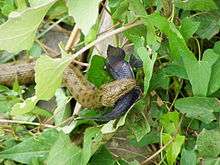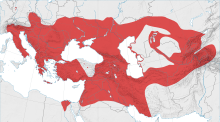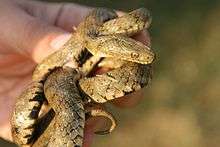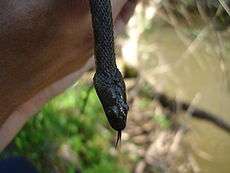Dice snake
| Dice snake | |
|---|---|
 | |
| Scientific classification | |
| Kingdom: | Animalia |
| Phylum: | Chordata |
| Class: | Reptilia |
| Order: | Squamata |
| Suborder: | Serpentes |
| Family: | Colubridae |
| Genus: | Natrix |
| Species: | N. tessellata |
| Binomial name | |
| Natrix tessellata (Laurenti, 1768) | |
 | |
| Distribution of the Natrix tessellata | |
| Synonyms | |
|
Coronella tessellata Laurenti, 1768 | |

The dice snake (Natrix tessellata) is a European nonvenomous snake belonging to the family Colubridae, subfamily Natricinae.
Brief description

Females are bigger than males. Maximum size is 1.0-1.3 m (39-51 inches) long. The color may vary from greyish green to brownish or almost black, with dark spots on the back. The belly is sometimes vividly coloured in yellow or orange, with black spots, very similar to dice, hence the name.
Biology
Living mainly near river streams or lakes, it frequently feeds on fish. Sometimes it feeds also on amphibians like frogs, toads and tadpoles.
Classified as non-venomous, Natrix tessellata produces a potent antihemorrhagin in its serum[3] and has been said to produce a neurotoxin through a gland in its mouth.[4] As a defense it spreads a very bad smelling secretion from its cloaca. Another defence mechanism is thanatosis, meaning playing dead.
During the mating season (March–April–May) they congregate in large groups. Egg laying is usually in July, and one clutch consists of 10-30 eggs. The young snakes hatch in early September.

Dice snakes hibernate from October to April in dry holes near the water.
Distribution
The dice snake is found throughout Europe and Asia: Lebanon, Israel, Germany, Switzerland, Austria, France, Croatia, Slovenia, Bosnia and Herzegovina, Montenegro, Republic of Macedonia, Serbia, Italy, Czech Republic, Slovakia, Poland,[5] Albania, Romania, Bulgaria, Hungary, Turkey, Greece, Cyprus, Afghanistan, Russia, Ukraine, Armenia, Georgia, Azerbaijan, Kazakhstan, Turkmenistan, Tajikistan, Uzbekistan, Kyrgyzstan, Iran, Iraq, Lebanon, Syria, Jordan, Yemen, Egypt, Pakistan, China, Macedonia.
Research projects
One of the most numerous populations lives in the vicinity of the ruins of Histria, in the Dobruja region, Romania. This population has been recently discovered to be threatened by a parasitic nematode of the genus Eustrongylides. Since 2005, the population from Histria has been in researchers' attention. For example, a joint Romanian-Swedish-Czech research program is focused on population biology studies and parasitic threats of this unique coastal population. An overview on Biology, Distribution and Conservation is given in[6]
References
- ↑ Aram Agasyan; Aziz Avci; Boris Tuniyev; Jelka Crnobrnja Isailovic; Petros Lymberakis; Claes Andrén; Dan Cogalniceanu; John Wilkinson; Natalia Ananjeva; Nazan Üzüm; et al. (2009). "Natrix tessellata ". IUCN Red List of Threatened Species. Version 2009.1 (3.1). International Union for Conservation of Nature. Retrieved 2009-03-25.
- ↑ Boulenger, G.A. 1893. Catalogue of the Snakes in the British Museum (Natural History), Volume I. London. pp. 233-234
- ↑ "A potent antihemorrhagin in the serum of the non-poisonous water snake Natrix tessellata: isolation, characterisation and mechanism of neutralisation". Biochimica et Biophysica Acta (BBA) - General Subjects. 1201 (3): 482–490. 1994-12-15. doi:10.1016/0304-4165(94)90080-9. ISSN 0304-4165.
- ↑ "Discovery Channel UK". www.facebook.com. Retrieved 2018-03-17.
- ↑ Vlcek, Petr; Bartlomiej Najbar and Daniel Jablonski. (2010) First records of the Dice Snake (Natrix tessellata) from the North-Eastern part of the Czech Republic and Poland. Herpetology Notes 3:23-26
- ↑ Mebert, Konrad (ed.): The Dice Snake, Natrix tessellata: Biology, Distribution and Conservation of a Palaearctic Species. Mertensiella 18, 2011, pp. 1-456.
| Wikimedia Commons has media related to Dice snake. |
